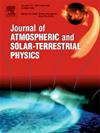A decline of linear relation between outgoing longwave radiation and temperature during geomagnetic disturbances
IF 1.8
4区 地球科学
Q3 GEOCHEMISTRY & GEOPHYSICS
Journal of Atmospheric and Solar-Terrestrial Physics
Pub Date : 2025-03-24
DOI:10.1016/j.jastp.2025.106503
引用次数: 0
Abstract
Climate modeling is the main instrument to predict future climate changes. Despite the recent advances in this field, there is still high uncertainty concerning the contribution of natural (including solar/geomagnetic activity) and anthropogenic factors to the current climate changes. Based on the observational data, we studied the linear relation between Outgoing Longwave Radiation (OLR) and Near-Surface Temperature (NST) under quiet and disturbed geomagnetic conditions 1979 through 2022. Water vapor (due to its optical properties) was established to be the main factor to cause a linear OLR-NST relation. The OLR-NST correlation in the optically thin atmosphere above 30° corresponds to quiet geomagnetic conditions and so does the anticorrelation between the above parameters in the optically thick low-latitude atmosphere. The winter ocean regions of the OLR-NST anticorrelation up to 60° in the both hemispheres under quiet geomagnetic conditions related to the clouds. We found the geomagnetic disturbances lead to decrease in the OLR response to the NST variations in the optically thin atmosphere within the mid- and high latitudes, particularly during spring. The considerable changes of linear OLR-NST relation are observed in the optically thick low-latitude atmosphere during geomagnetic disturbances.
地磁扰动期间外发长波辐射与温度线性关系的减弱
气候模式是预测未来气候变化的主要手段。尽管这一领域最近取得了进展,但关于自然(包括太阳/地磁活动)和人为因素对当前气候变化的贡献仍然存在很大的不确定性。基于实测资料,研究了1979 ~ 2022年安静和扰动地磁条件下,长波辐射(OLR)与近地表温度(NST)的线性关系。水蒸气(由于其光学性质)被确定为引起线性OLR-NST关系的主要因素。在30°以上的光学稀薄大气中,OLR-NST相关对应于安静地磁条件,在光学厚的低纬度大气中,上述参数之间的反相关也对应于安静地磁条件。在与云相关的安静地磁条件下,OLR-NST的冬季海洋区在两个半球的反相关高达60°。研究发现,地磁扰动导致中高纬度光学稀薄大气的OLR对NST变化的响应减弱,特别是在春季。在地磁扰动期间,观测到光学厚低纬度大气中线性OLR-NST关系的显著变化。
本文章由计算机程序翻译,如有差异,请以英文原文为准。
求助全文
约1分钟内获得全文
求助全文
来源期刊

Journal of Atmospheric and Solar-Terrestrial Physics
地学-地球化学与地球物理
CiteScore
4.10
自引率
5.30%
发文量
95
审稿时长
6 months
期刊介绍:
The Journal of Atmospheric and Solar-Terrestrial Physics (JASTP) is an international journal concerned with the inter-disciplinary science of the Earth''s atmospheric and space environment, especially the highly varied and highly variable physical phenomena that occur in this natural laboratory and the processes that couple them.
The journal covers the physical processes operating in the troposphere, stratosphere, mesosphere, thermosphere, ionosphere, magnetosphere, the Sun, interplanetary medium, and heliosphere. Phenomena occurring in other "spheres", solar influences on climate, and supporting laboratory measurements are also considered. The journal deals especially with the coupling between the different regions.
Solar flares, coronal mass ejections, and other energetic events on the Sun create interesting and important perturbations in the near-Earth space environment. The physics of such "space weather" is central to the Journal of Atmospheric and Solar-Terrestrial Physics and the journal welcomes papers that lead in the direction of a predictive understanding of the coupled system. Regarding the upper atmosphere, the subjects of aeronomy, geomagnetism and geoelectricity, auroral phenomena, radio wave propagation, and plasma instabilities, are examples within the broad field of solar-terrestrial physics which emphasise the energy exchange between the solar wind, the magnetospheric and ionospheric plasmas, and the neutral gas. In the lower atmosphere, topics covered range from mesoscale to global scale dynamics, to atmospheric electricity, lightning and its effects, and to anthropogenic changes.
 求助内容:
求助内容: 应助结果提醒方式:
应助结果提醒方式:


